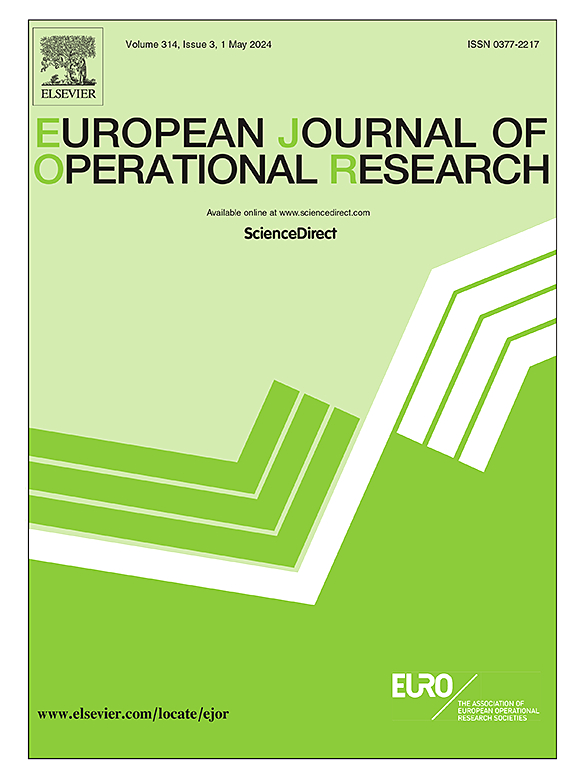Enhancing Waste Collection: A Branch-and-Cut-and-Price approach for the Periodic Vehicle Routing Problem with Intermediate Facilities applied to a real-world case study
IF 6
2区 管理学
Q1 OPERATIONS RESEARCH & MANAGEMENT SCIENCE
引用次数: 0
Abstract
The paper at hand deals with a real-world waste collection problem, which is modeled as a periodic vehicle routing problem with intermediate facilities. Therein, a route plan must be defined for each day of the planning horizon such that all customers are served according to one of their visiting schemes and the total travel time is minimized. We present an enhanced compact formulation and a branch-cut-and-price approach for its resolution, incorporating a new set of valid inequalities that exploit the coprimality of the customers’ visit frequencies. We compare the solution of the new compact formulation via a MIP-solver with the branch-cut-and-price algorithm on asymmetric instances of up to 50 customers, developed with our industry partner to reflect the characteristics of the waste collection sector. While the MIP-solver cannot solve a single instance to optimality, our branch-cut-and-price algorithm solves instances with up to 40 customers considering a four-day planning horizon, and all instances with 20 customers for a six-day planning horizon. To benchmark our algorithm, we test it on instances for multi-period problems from the literature. Our results are competitive with state-of-the-art methods, yielding 5 new proven optimal solutions, 4 new best upper bounds, and 32 new best lower bounds. Moreover, in a case study regarding organic waste collection provided by our business partner, we solved a real-world instance with more than 1000 customer locations. The resulting route plan achieves significant cost savings compared to the company’s current practice.加强废物收集:一种分支-削减-价格方法用于具有中间设施的周期性车辆路线问题的实际案例研究
本文处理的是一个现实世界中的垃圾收集问题,该问题被建模为具有中间设施的周期性车辆路径问题。其中,必须为规划范围内的每一天定义路线计划,使所有的客户都按照他们的访问计划之一得到服务,并使总旅行时间最小化。我们提出了一个增强的紧凑公式和分支降价方法来解决这个问题,并结合了一组新的有效不等式,利用了客户访问频率的共同性。我们通过mip求解器将新紧凑型配方的解决方案与最多50个客户的不对称实例的分支降价算法进行比较,该算法与我们的行业合作伙伴一起开发,以反映废物收集行业的特点。虽然mip求解器不能将单个实例求解到最优状态,但我们的分支削减和价格算法可以解决具有最多40个客户的实例,考虑四天的规划范围,并且可以解决具有20个客户的所有实例,考虑六天的规划范围。为了对我们的算法进行基准测试,我们在文献中的多周期问题的实例上进行了测试。我们的结果与最先进的方法具有竞争力,产生了5个新的已证明的最优解,4个新的最佳上界和32个新的最佳下界。此外,在我们的业务合作伙伴提供的关于有机废物收集的案例研究中,我们解决了一个拥有1000多个客户地点的实际实例。与公司目前的做法相比,由此产生的路线规划大大节省了成本。
本文章由计算机程序翻译,如有差异,请以英文原文为准。
求助全文
约1分钟内获得全文
求助全文
来源期刊

European Journal of Operational Research
管理科学-运筹学与管理科学
CiteScore
11.90
自引率
9.40%
发文量
786
审稿时长
8.2 months
期刊介绍:
The European Journal of Operational Research (EJOR) publishes high quality, original papers that contribute to the methodology of operational research (OR) and to the practice of decision making.
 求助内容:
求助内容: 应助结果提醒方式:
应助结果提醒方式:


